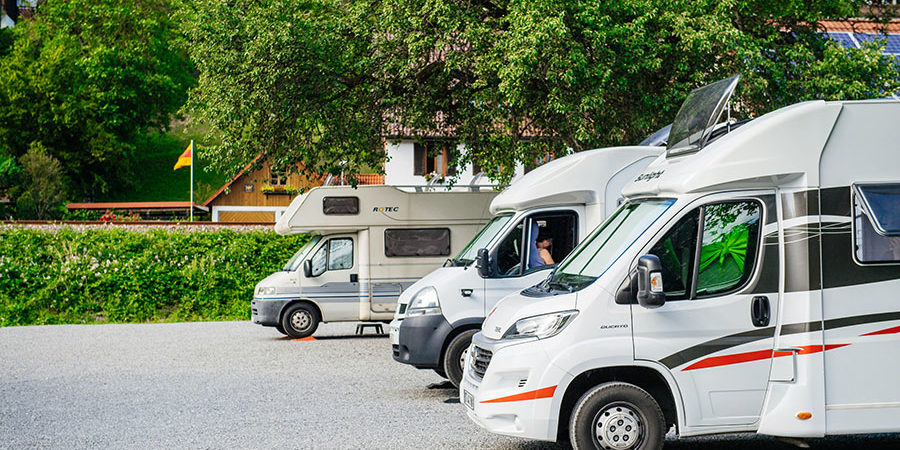Have you ever come home from vacation and struggled to find a place to store your RV? We know that finding parking for your RV can be complicated, expensive, and inconvenient. However, with the right preparation, your front yard can be the perfect spot to store your RV at home!
In this article, we’ll cover some of the important considerations when installing and your very own parking pad. This includes evaluating your property, RV parking pad ideas, choosing the right material, and how to get started.
Evaluate Your RV and Land
Before building your RV parking pad, you should consider a few things about your RV and your yard. Depending on the conditions of your land and the weight and size of your RV, you might choose certain materials over others.
RV Weight & Height
Pay special attention to the weight of your RV when choosing a parking pad option. Extremely heavy loads can easily destroy certain materials, tearing up your yard and jeopardizing your RV in the process. Heavy RVs should only be parked on materials rated for that weight, especially for long-term storage. This can make the cheaper material options worth reconsidering, as they tend to have lower weight limits.
Also carefully measure the height of your RV when choosing a spot to place your parking pad. Make sure you have adequate clearance for your vehicle. This might seem obvious, but it’s always worth being sure. A low-hanging tree limb or the eave of your roof could interfere with the functionality of your parking pad.
Levelness & Accessibility
When building an RV pad, you want to be sure the site is level and easy to access. Uneven RV pads can be susceptible to flooding and puddles in stormy weather. Parking your RV on an unlevel pad can also cause stress and damage to the frame and wheels. The last thing you want is your RV rolling away on accident!
It is also important to make sure you will be able to easily access your parking pad. Parking an RV can be difficult, especially in tighter spaces. When choosing your site, ensure that you have adequate space to maneuver and load your vehicle.
RV Parking Pad Ideas
The following is a list of front-yard RV parking pad ideas, each with its own pros and cons. Consider all of the factors outlined above when choosing your material. A good RV parking pad design can be a lifesaver, but a bad one can turn into a nightmare quickly.
Dirt
While a very cheap option, dirt erodes easily and cannot support heavy loads. Dirt parking pads can also be messy to have in your yard due to mud and dust. If you’re in a pinch, dirt will work for a while because it does not require any settling time.
However, it will need to be replenished every couple of weeks in wet weather. Grass is another option but, unfortunately, it has the same drawbacks as dirt.
Gravel
Relatively cheap and widely available, a gravel parking pad can be a suitable short-term option for your RV or travel trailer. Before pouring in gravel, you’ll likely need to dig to a certain depth, level your ground, and install a sub-base material. Unsupported gravel and crushed rock does require regular maintenance, time to settle after installation, and cannot support heavy loads in the long run.
Asphalt
Asphalt can be a good material for your RV pad. The installation is quick, only requiring a couple of days of labor and curing time. This also keeps costs low, as you’re not paying for an extensive install time. Furthermore, asphalt is recyclable, making it an environmentally conscious option.
Asphalt does require the installation of a sub-base material, and it requires preventative maintenance to extend its lifespan. Asphalt is susceptible to potholes in winter weather, which require repair year after year.
Concrete
Concrete is a stronger and more durable option than dirt, gravel, and asphalt. This sturdy material can withstand harsh weather conditions and has relatively few maintenance requirements. You’ll also be able to choose from a wide variety of colors and textures to suit your personal style.
Unfortunately, concrete can be very expensive and slow. It is less cost-effective because it requires a sub-base and professional installation. Once it has been professionally installed, concrete pads can require several weeks to settle.
BaseCore Geocells
BaseCore Geocell is a military-grade material that provides support and structure to your desired top-layer material. BaseCore geocell is used in many different foundations such as roads, parks, carports, and of course, RV parking pads.
Due to its porous nature, when paved with permeable pavers, BaseCore Geocell allows water to drain. This prevents the formation of ice and mud and preserves good soil conditions. Although it is permeable, BaseCore Geocell provides a vapor barrier to prevent ground moisture from collecting on your RV’s underbelly.
BaseCore Geocell is installed under the material of your choice. This allows you to have all the benefits of a well-thought RV parking pad design!
Choose the Best Material for Your RV Parking Pad
If you are ready to install your new parking pad but have a few questions, we are here to help! Our team of experts has helped with many RV parking pad projects!
Backyard Bases proudly supplies RV owners with high-quality BaseCore Geocell products designed to meet your RV storage needs. You can access our FAQ page or contact us directly for further information at (888) 897-2224.
